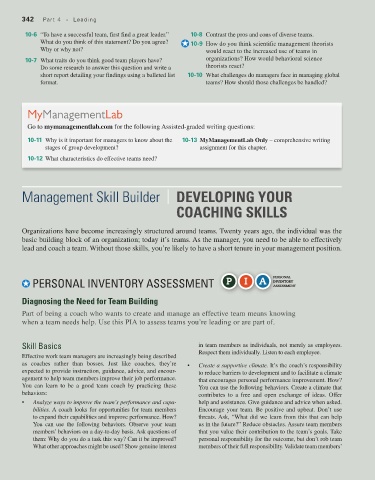Page 343 - Fundamentals of Management Myths Debunked (2017)_Flat
P. 343
342 Part 4 • Leading
10-6 “To have a successful team, first find a great leader.” 10-8 Contrast the pros and cons of diverse teams.
What do you think of this statement? Do you agree? 10-9 How do you think scientific management theorists
Why or why not? would react to the increased use of teams in
10-7 What traits do you think good team players have? organizations? How would behavioral science
Do some research to answer this question and write a theorists react?
short report detailing your findings using a bulleted list 10-10 What challenges do managers face in managing global
format. teams? How should those challenges be handled?
MyManagementLab
Go to mymanagementlab.com for the following Assisted-graded writing questions:
10-11 Why is it important for managers to know about the 10-13 MyManagementLab Only – comprehensive writing
stages of group development? assignment for this chapter.
10-12 What characteristics do effective teams need?
|
Management Skill Builder DeveLopIng Your
CoaChIng skILLs
Organizations have become increasingly structured around teams. Twenty years ago, the individual was the
basic building block of an organization; today it’s teams. As the manager, you need to be able to effectively
lead and coach a team. Without those skills, you’re likely to have a short tenure in your management position.
PERSonAl InvEnToRy ASSESSmEnT P I A PERSONAL
INVENTORY
ASSESSMENT
Diagnosing the need for Team Building
Part of being a coach who wants to create and manage an effective team means knowing
when a team needs help. Use this PIA to assess teams you’re leading or are part of.
Skill Basics in team members as individuals, not merely as employees.
Respect them individually. Listen to each employee.
Effective work team managers are increasingly being described
as coaches rather than bosses. Just like coaches, they’re • Create a supportive climate. It’s the coach’s responsibility
expected to provide instruction, guidance, advice, and encour- to reduce barriers to development and to facilitate a climate
agement to help team members improve their job performance. that encourages personal performance improvement. How?
You can learn to be a good team coach by practicing these You can use the following behaviors. Create a climate that
behaviors: contributes to a free and open exchange of ideas. Offer
• Analyze ways to improve the team’s performance and capa- help and assistance. Give guidance and advice when asked.
bilities. A coach looks for opportunities for team members Encourage your team. Be positive and upbeat. Don’t use
to expand their capabilities and improve performance. How? threats. Ask, “What did we learn from this that can help
You can use the following behaviors. Observe your team us in the future?” Reduce obstacles. Assure team members
members’ behaviors on a day-to-day basis. Ask questions of that you value their contribution to the team’s goals. Take
them: Why do you do a task this way? Can it be improved? personal responsibility for the outcome, but don’t rob team
What other approaches might be used? Show genuine interest members of their full responsibility. Validate team members’

